| Forest
Disturbance Question |
Ernie
Ostuno |
| Mar
12, 2006 16:16 PST |
I am working on a project commemorating the 50th anniversary of
an F5
tornado that roared through western Michigan on April 3, 1956.
One of
the things I am doing is tracing the path of the storm and
looking for
evidence of the storm's passage that still exist after 50 years.
One of
the few forested areas hit by this tornado that hasn't changed
much
since 1956 is a township park that consists of about 100 acres
of trees.
The tornado passed through these woods shortly after it touched
down. I
visited the area last month and found a row of old, gnarled
"witness
trees" along the southern extent of the wooded area. I
believe this was
a pasture that reverted to woodlands about 100 years ago and the
witness
trees marked the southern border of it. The witness trees are
mostly
sugar maples and beech that I am guessing are around 150 years
old. They
do not appear to have been heavily damaged in the past. A
retired farmer
who lived across from this area told me the tornado left a 200
foot wide
swath through the woods where the trees were either sheared off
or
uprooted. He did not know if the fallen trees were removed. I
saw no
obvious signs of this disturbance when I visited last month. All
I found
were the witness trees and an apparently even-aged stand of
beech,
maple, oak and black cherry surrounding them. Question: if any
of these
species of trees were felled 50 years ago, and assuming they
were not
removed, would there be any trace of the remaining logs and
stumps or
would they have largely decomposed to the point of not being
recognizable?
Ernie |
| Tornado
Damage 50 Years Later |
Ernie
Ostuno |
| Mar
15, 2006 14:30 PST |
Lee, Don,
I went back there yesterday. I did find some pits/mounds along
with old
stumps, but I suppose that I'd be hard pressed to prove these
were
evidence of a tornado in 1956. However, I did find some
interesting
looking crowns and trunks that indicated some type of
disturbance from
several decades ago. I took several photos.
Ernie
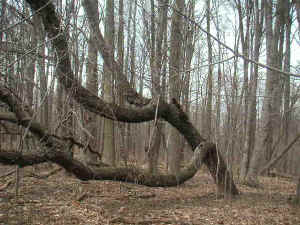
Black cherry as of 2006 was at the edge of the forest
at the time of the tornado in 1956 and bent by the wind. |
|
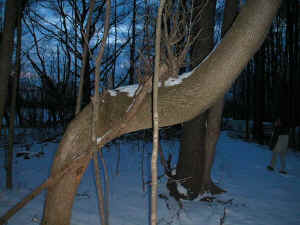
A tree (as of 2006) bent as a small sapling when a
larger tree fell on it during the 1956 tornado. |
|
|
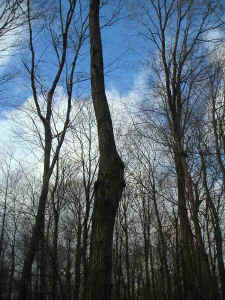
A large sugar maple as of 2006, which lost
a large
limb comprising half of its crown in the 1956 tornado.
|
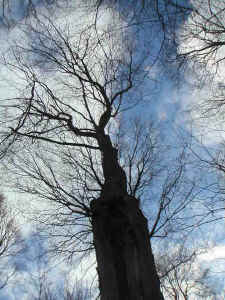 |
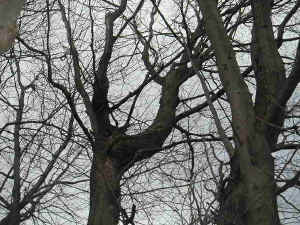
A crook in the trunk of a large sugar maple as of
2006, formed when part of the crown was torn off by the
1956 tornado.
|
|
|
| Re:
Forest Disturbance Question |
Dean
Hedin |
| Mar
12, 2006 23:58 PST |
Several years back (2000?) we had an unusual set of tornados
past through
eastern PA.
My brother and his family were in the midst of it. Fortunately,
one just
missed his home but
it managed to destroy several neighbors homes and uprooted trees
very close.
I had to go over there
the next morning and chainsaw a felled tree so he could get out
of his
driveway.
In the back of his house is a heavily wooded area. I have
visited many
times since and have observed
the initial damage and the recovery over the years.
Many trees that were not felled had large foliage/limbs removed
from the
tops of the trees. Giving them an almost
"bonsai" appearance. These features
remain to this day on many of these
trees and I suspect will remain for the remaining life of these
trees.
For the most part, large, older growth, trees are what uprooted.
These were
typically very tall species like pin oaks where the
wind could take advantage of leverage to rip them out. Many of
the felled
trees were very close together, in clusters.
Today, many of these logs are beginning to rot, and the craters
where the
roots were pulled out still remain.
After fifty years I think you might still see some remaining
felled logs,
especially since it was the larger trees that typically fell.
This summer my brother and I noticed that many young honey
locust trees are
filling in the areas where the larger trees felled.
These are growing very quickly and are at a high density.
|
| Re:
Forest Disturbance Question |
Lee
E. Frelich |
| Mar
13, 2006 07:23 PST |
Ernie:
The logs of all hardwoods would have completely rotted away
after 50 years.
Pine or hemlock logs might still be visible, but you did not
have those
species.
For my Ph.D. I reconstructed wind disturbance history in the
Porcupine
Mountains and Sylvania in Upper Michigan. A tornado or downburst
creates
an area of young even-aged forest, with a few scattered larger
trees that
survived (many with crooks in them that were formed by crown
breakage and
reiteration of a new crown after the storm). The saplings on the
forest
floor at the time of the storm usually survive, and often show a
release
from suppression in their rings that marks the year after the
storm. These
saplings get more sunlight after the bigger canopy trees are
downed and
their rings suddenly increase in width the next year ands
continue to be
much wider for at least a few decades.
Lee
|
| RE:
Forest Disturbance Question |
Ernie
Ostuno |
| Mar
13, 2006 15:05 PST |
Dean,
I think that would have been either May 31 or June 2, 1998.
There were
two tornado outbreaks in east PA within a couple days of each
other that
year. I remember this well since I was working for the State
College, PA
National Weather Service office at the time and did several
storm
surveys in the following days. One of the places that got hit
hard was
Promised Land State Park.
If you want to see some more interesting post-tornado "tree
sculptures"
go to East Brach Swamp Natural Area on Route 144 south of Renovo
in
central PA. This is where a huge F4 tornado hit a patch of old
growth
hemlocks during the May 31, 1985 outbreak. It did leave a few
trees
standing. Here's my description of the site:
http://www.nativetreesociety.org/fieldtrips/penna/east_branch_swamp_natural_area.htm
Another tornado on May 31, 1985 flattened a large segment of the
Tionesta Natural area. It seems that May 31 has been a bad day
for old
growth in Pennsylvania.
Ernie
|
| RE:
Forest Disturbance Question |
Ernie
Ostuno |
| Mar
13, 2006 15:49 PST |
Lee,
I was afraid of that. I was hoping the many large beech stumps
left by
the tornado as described by the farmer would be at least faintly
evident, but I have seen how quickly the hardwoods that were
felled by
the 1998 derecho are decomposing after only seven years. Well
maybe
there are some pits and mounds that I could find. I am going to
return
to that woods tomorrow as I just did a path map re-analysis and
it looks
like the tornado path is actually a little further east than the
stretch
of woods I walked last month. This would explain why the witness
trees
are still standing and don't appear to have any unusual looking
crowns.
If only I could find a dendrochronologist in the area to tag
along...
Ernie
|
| Re:
Forest Disturbance Question |
Edward
Frank |
| Mar
13, 2006 18:25 PST |
Ernie,
I took numerous photos of the fallen cucumbertree at Cook
Forest. It has
been down for less than a year. I hope to photograph it
periodically to
document the decompoisition process - what species grow on the
fallen log at
what point in its decay history - what physical changes occur in
the fallen
tree itself. I am sure this has been done before, but I am doing
it again.
I should record the status of the fallen trees that are left
from the major
tornado at Cook Forest years ago - a quick jump in time from the
current
fallen log.
Ed
|
| Re:
Forest Disturbance Question |
Don
Bertolette |
| Mar
13, 2006 19:52 PST |
Lee/Ernie-
While they may be subtle after 50 years, would there still be
tip-up mounds?
-Don
|
| Re:
Forest Disturbance Question |
Lee
E. Frelich |
| Mar
14, 2006 06:02 PST |
Don:
Yes, tip up mounds would still be visible, but they may be
hundreds or
thousands of years old--you can't be sure they were formed by a
given
tornado. That is because after each disturbance trees on tip up
mounds are
more likely to succeed, and then they blow down again,
augmenting the same
tip up mound. Some tip up mounds do go vacant (i.e. have no tree
on them)
for periods of decades or a few centuries though.
Lee
|
| RE:
Forest Disturbance Question |
Ernie
Ostuno |
| Mar
15, 2006 14:23 PST |
Ed,
That is a project I can relate to. I have been periodically
visiting a
fallen white oak for the last 31 years. It is very slowly
decomposing. I
first found it in December, 1974 after my father told me of
three giant
white oaks he remembered being in a cow pasture that had been
reverting
to forest since 1950. I found all three. I am guessing they were
all in
the 300 year old range. Two of them were dead, and one had
fallen. The
dead one that was standing gradually lost all its large limbs
over the
years and is now just a 20 foot tall stump. So the wood of the
dead
trees has persisted for at least 31 years after the trees died,
and
probably at least several years longer.
The other one is still alive and healthy as of last December.
Ernie
|
| RE:
Forest Disturbance Question |
foresto-@npgcable.com |
| Mar
15, 2006 14:32 PST |
Ernie-
I'm envisioning an extended time lapse photography project, with
one year
between shots...any photos recording this decomp process?
-DonB
|
| RE:
Forest Disturbance Question |
Ernie
Ostuno |
| Mar
17, 2006 01:02 PST |
Don,
I have lots of photos of the living tree, which hasn't changed
hardly at
all in appearance over the past 30 years. I have only one photo of
the
fallen tree, which was taken in December, 1998. It would have been
nice
to have taken close up photos about once every 5-10 years. The
changes
have been very gradual. The standing tree would have been a more
interesting subject, as it was continuously shedding limbs over
the
years, until there was nothing left but a 20 foot snag, which
continues
to crumble.
Ernie
|
| RE:
Forest Disturbance Question |
wad-@comcast.net |
| Mar
17, 2006 03:42 PST |
ENTS
I found out through my friend Megan (a lurker here) that the osage
orange at Tyler arboretum was planted some time in the early
1800's. It fell over in 1954. If you saw this tree today, you
would think it fell over a couple of years ago. Barely any rot.
One to watch.
Lee, can there be differences in location for how fast a log rots?
I realize the obvious climate differences would be a factor, but
Mn to Pa? When you say a tree lasts over one hundred years, is it
a mushy, punky resemblance of a log, or a somewhat rigid log? I
guess the length of the warm season is a multiplier, as it gives
the insects that much more time to munch?? Of course the intial
size must be a factor. I find this very interesting. Do you know
of any links I could read on the subject?
Scott
|
| RE:
Forest Disturbance Question |
Lee
E. Frelich |
| Mar
17, 2006 05:55 PST |
Scott:
Rotted logs are usually categorized as solid with bark, solid
without bark,
somewhat punky, very punky, and part of the forest floor but still
visible,
and finally, gone. This decay process depends on how warm (higher
decay
rates with longer summers) and wet a site is (higher decay with a
summer-wet climate, and in shaded conditions; little decay in
summer dry
climates or if saturated with water), as well as whether a log is
case
hardened before it falls to the ground (i.e. weathered to a gray
color,
which greatly reduces decay rate), and the chemical properties of
the wood
and size of the log. A 20 inch diameter white pine log in a
northern
Minnesota forest may take 100 years to become part of the forest
floor and
200 years before it is totally gone. The same log may take half
that time
in a warm wet climate, or twice that long in a desert climate, or
100 times
that long if the log is submerged in a bog. A 20 inch sugar maple
log in a
northern MN forest may take 40-50 years to disappear and a 5 inch
diameter
log may disappear in only 20 years. A 20 inch diameter log in a
warm
climate like southern New England may disappear in 20-30 years.
These are educated guesses based on my field experience. I am not
aware of
any model that allows universal calculation of decay times for
many
different species under many different climates (if anyone has
heard of
such a thing let me know). There are a lot of case studies of
decay for
specific areas.
Lee
|
| Re:
Forest Disturbance Question |
Don
Bertolette |
| Mar
17, 2006 18:43 PST |
Ernie-
Have you ever seen the primitive cinematic technique where
successive
images, each one slightly different, when flipped at a rate of one
or two a
second make figures dance?
I have a vision of your tree dancing in my head...one year
intervals through
out one's life, or more to the point, through out the life of a
tree would
be an interesting project....so few of us are geographically
permanent
enough, and persistent in this fashion, that it isn't likely to be
very
common/popular, but certainly interesting to me...
-DonB
|
| RE:
Forest Disturbance Question |
Pamela
Briggs |
| Mar
17, 2006 19:33 PST |
Dear Don --
Here are some relatively short time-lapse clips of living trees.
Laburnum, 11 months:
http://www.haworth-village.org.uk/nature/time-lapse/time-lapse.asp?pic=16
Maple, two weeks:
http://mvh.sr.unh.edu/mvhtools/greenup.htm
[click on either "23 mb" or "128 mb" to
watch]
Pamela
==============================================================================
TOPIC: Tornado book (with an assist by Lee Frelich)
http://groups.google.com/group/entstrees/browse_thread/thread/ef16d890c20d7fd6?hl=en
==============================================================================
== 1 of 2 ==
Date: Tues, May 20 2008 1:55 pm
From: ERNEST.OSTUNO@noaa.gov
ENTS,
The Grand Rapids (Michigan) Historical Society has recently
published
a book I wrote about a tornado outbreak that struck western
Lower
Michigan on April 3, 1956. What does this have to do with ENTS
you
ask? Well our own forest disturbance expert Lee Frelich is
acknowledged in the book for his helping me identify several
trees
that are still living and show the scars from the F5 tornado
that
struck near Hudsonville, Michigan on that day. The background
discussion on this can be read here:
http://www.nativetreesociety.org/fieldtrips/michigan/1956tornado/forest_disturbance.htm
The book is being advertised off the GRHS website:
http://www.grhistory.org/id37.htm
Thanks Lee!
Ernie
|
|